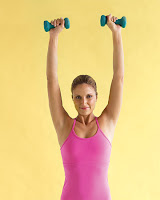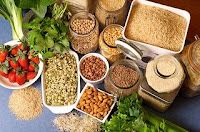Arm Exercises
An Upper-Body Boost
Your arms and shoulders take part in almost everything you'll do this summer, from carrying a cooler to the beach to playing tennis to performing Downward Facing Dog. But unless you're lugging around lots of heavy objects on a daily basis, they're probably not reaching their full potential.To build strength, endurance, and resilience in your upper-body muscles, try the following exercises twice a week. Your newfound strength will give you a boost of confidence -- not to mention, you'll look great in a tank top
Upper Body: Pilates Chest Expansion
What it does: Strengthens the triceps and deltoids, as well as core muscles. Increases lung capacity, expands the chest, and strengthens back muscles.How to do it: Hold a 2- to 3-pound weight in each hand. Stand with heels touching and toes pointed out about 45 degrees (don't force your feet apart beyond their natural range). Squeeze thighs together and engage the buttocks and abdominal muscles, creating one long line with the body. With your arms extended forward at shoulder height, take a deep breath, filling out the chest, and press the arms straight back as high as you can, maintaining your position. Holding your breath, turn your head left, center, right, and back to center. Exhale and lower arms. Repeat 4 to 6 times.
Upper Body: Swimming
What it does: Works the muscles of the back, deltoids, legs, and triceps. Increases shoulder stability. Engages and strengthens the core.
How to do it: Stand with feet parallel, hip-width apart. Bend over at 90 degrees (or less if this is too difficult). Keep knees slightly bent and engaged. With weights by your ears, inhale deeply and extend the left arm out straight in front of you (palm down), and the right arm behind you (palm up). Draw arms back in. Repeat on the other side. Do 4 to 8 times.
Upper Body: Active Cat
What it does: Strengthens the entire front and back of the upper body, as well as the lower back and glutes in a Vinyasa-type flow.
How to do it: Start in a modified push-up position, knees on the floor. Inhale and lift your right leg up and back, opening up the hip and working the lower back. Exhale, lowering the upper body to 3 to 5 inches above the mat. Inhale and return to push-up position, and then exhale, curling your body under and drawing your right knee into your forehead. (See next slide.) Repeat with the other leg. Alternate, doing 3 to 5 reps on each side.
Arms: Plie with Bicep Curls
What it does: Works the biceps; strengthens legs and arms together for faster results.
How to do it: Stand with legs 3 feet apart, toes rotated out, knees pointing over the toes. Hold a 2- to 3-pound weight in each hand. (For a greater challenge, increase to 5 pounds.) Engage your core and buttock muscles. Bend your knees to a challenging (but not painful) degree, keeping your spine tall and your knees aligned with your second and third toes, as you raise your hands to your collarbone. (See next slide.) Hold for 3 breaths, and return to starting position. Repeat 10 to 15 times. Do 3 sets.
Plie with Bicep Curls: Step 2
Arms: Tricep Press
How to do it: Hold a 2- to 3-pound weight in each hand. (For a greater challenge, increase to 5 pounds.) Stand with feet shoulder-width apart, bending at the hips with a flat back. Let your arms hang down, palms back. Take a breath and then exhale, pressing the arms back until they're slightly raised above the hips. (See next slide.) Repeat 10 to 15 times. Do 3 sets.
Tricep Press: Step 2
Stability-Ball Workout: Modified Push-Up
How to do it: Stand with your left side facing the front of a chair that has no arms (you can also use a bench), holding a weight in your right hand. Bend and rest your left knee on the chair, grabbing the side edge of the chair with your left hand; your right arm should extend down toward the floor. Keep your spine straight and core tight. Moving to a three count, bend the right elbow and lift the weight straight up. Slowly return to the starting position using a three count. Complete 8 to 12 reps. Switch sides and repeat with weight in left hand.
How to do it: Stand tall with a weight in each hand. Keeping your core tight, raise the weights until your hands are at the same level as your ears; palms facing forward and elbows pointing out. This is the starting position. Press the weights straight up to a count of three (see next slide), then lower them back to the starting position to a count of three. Do 8 to 12 reps.
How to do it: Stand with feet hip-distance apart, arms by your sides and weights in your hands. Keeping your body stationary, core engaged, and shoulders down, draw your shoulder blades back so they reach toward each other. Now, to a count of three, slowly lift your shoulders up toward your ears as far as you can go without compressing your neck. (See next slide.) Then lower them back to the starting position, also for a count of three. Repeat for 8 to 12 reps.
What it does: Improves upper-body strength without strain.
How to do it: Press your belly into the top of a stability ball. Extend your arms down to the floor. Position yourself on the ball so all of your torso and hips are in front of the ball and your shoulders are directly aligned above your wrists. Keep fingers pointing forward. As you inhale, bend your elbows and lower your upper body toward the floor, keeping abdominals strong. (See next slide.) On an exhale, straighten your elbows. Repeat 8 to 10 times.
Modified Push-Up: Step
Shoulders: One-Arm Row
What it does: Works the rhomboids and latissimus dorsi as well as the biceps, making it easier to pick up heavy items. Also wards off age-related loss of flexibility in the shoulder joint.How to do it: Stand with your left side facing the front of a chair that has no arms (you can also use a bench), holding a weight in your right hand. Bend and rest your left knee on the chair, grabbing the side edge of the chair with your left hand; your right arm should extend down toward the floor. Keep your spine straight and core tight. Moving to a three count, bend the right elbow and lift the weight straight up. Slowly return to the starting position using a three count. Complete 8 to 12 reps. Switch sides and repeat with weight in left hand.
Shoulders: Overhead Press
What it does: Works the deltoids and trapezius, along with the triceps. Builds strength for overhead lifting and movements, making it easier to perform actions such as retrieving items off high shelves or powering up a tennis serve.How to do it: Stand tall with a weight in each hand. Keeping your core tight, raise the weights until your hands are at the same level as your ears; palms facing forward and elbows pointing out. This is the starting position. Press the weights straight up to a count of three (see next slide), then lower them back to the starting position to a count of three. Do 8 to 12 reps.
Overhead Press: Step 2
Shoulders: Shrug
What it does: Builds strength and endurance in the trapezius and rhomboids, as well as in the levator scapulae. Helps prevent injuries when performing overhead actions such as lifting luggage into a bin, and makes it easier to carry heavy items for long distances.How to do it: Stand with feet hip-distance apart, arms by your sides and weights in your hands. Keeping your body stationary, core engaged, and shoulders down, draw your shoulder blades back so they reach toward each other. Now, to a count of three, slowly lift your shoulders up toward your ears as far as you can go without compressing your neck. (See next slide.) Then lower them back to the starting position, also for a count of three. Repeat for 8 to 12 reps.
Shoulder Shrug: Step 2
check more tone Head to toe ..... coming soon































